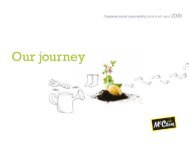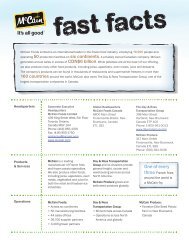From the Ground Up - McCain Foods Limited
From the Ground Up - McCain Foods Limited
From the Ground Up - McCain Foods Limited
You also want an ePaper? Increase the reach of your titles
YUMPU automatically turns print PDFs into web optimized ePapers that Google loves.
LEFT: The control room in <strong>the</strong><br />
Matougues, France, factory.<br />
rIGhT: State-of-<strong>the</strong>-art<br />
machinery optimizes raw<br />
material use.<br />
Making <strong>the</strong> most of a potato means converting <strong>the</strong> highest possible amount of<br />
it into french fries. It also means that as much as possible of <strong>the</strong> rest gets converted<br />
into o<strong>the</strong>r saleable potato products. To give every plant a model to strive for, Morris<br />
and his team designed <strong>the</strong> perfect factory on paper. It was called Plant X. “We took in<br />
<strong>the</strong> very best of every facility we had and <strong>the</strong> very best of all <strong>the</strong> knowledge we had,<br />
and we designed this plant on paper that could give us certain recoveries and certain<br />
costs,” Morris explains.<br />
To implement <strong>the</strong> program, Morris formed a committee consisting of him, Neil<br />
D’Souza, David Rogers, and Lloyd Borowski. By comparing each existing plant with<br />
Plant X, <strong>the</strong> committee was able to come up with a capital budget to bring all of <strong>the</strong>m<br />
up to state-of-<strong>the</strong>-art level. At <strong>the</strong> same time, each plant would be standardized in<br />
its processing procedures, so that all <strong>the</strong> plants around <strong>the</strong> world would receive, cut,<br />
process, and package potatoes in <strong>the</strong> same way.<br />
Implementing RMU requires that every factory, old or new, has <strong>the</strong> latest technology<br />
and methodology. “It was basically <strong>the</strong> handling of that raw material to cut it in<br />
<strong>the</strong> most efficient way so that everything is used for finished product,” says Morris.<br />
RMU didn’t really include anything that wasn’t already well known within <strong>the</strong> company<br />
– it was just a matter of putting it all toge<strong>the</strong>r in one package and taking it to<br />
each factory. By giving each factory help in its areas of weakness, <strong>the</strong> average level of<br />
productivity was raised.<br />
It’s a matter of applying knowledge in a systematic and comprehensive way.<br />
“Through RMU, we upgraded <strong>the</strong> shortcomings in all our factories,” says Morris.<br />
“Even though <strong>the</strong>re were many changes during my time at <strong>McCain</strong>, that is probably<br />
our most rewarding operation.”<br />
how french fries are made<br />
In <strong>the</strong> fifty years since <strong>McCain</strong> started making frozen french fries<br />
at Florenceville, <strong>the</strong> manufacturing process has been constantly<br />
improved, with <strong>the</strong> aim of producing <strong>the</strong> best french fry at <strong>the</strong><br />
lowest cost with <strong>the</strong> greatest efficiency. In 2007, it takes one hour<br />
to transform a raw potato into frozen and packaged french fries.<br />
3. Workers near <strong>the</strong> start of <strong>the</strong> line pick<br />
out bad potatoes and remove foreign<br />
matter.<br />
7. After drying, <strong>the</strong> potato strips are put<br />
on <strong>the</strong> equilibriation belt to balance <strong>the</strong><br />
moisture within <strong>the</strong> potato strip.<br />
11. The machine <strong>the</strong>n folds, seals, and<br />
cuts <strong>the</strong> bags into packages for <strong>the</strong><br />
food service market.<br />
4. Potatoes are shot by a water gun<br />
through knives that cut <strong>the</strong>m into<br />
strips.<br />
8. After equilibriation, <strong>the</strong> potato<br />
strips are fried.<br />
12. Machines pack <strong>the</strong> bags into<br />
cardboard boxes and <strong>the</strong>n onto<br />
pallets, which are stored at -23°<br />
Celsius until shipped.<br />
1. <strong>McCain</strong> plants are located near<br />
potato farms. Here, fresh potatoes are<br />
unloaded into storage bins.<br />
5. Automatic defect-removal<br />
machines rid <strong>the</strong> cut potatoes of any<br />
remaining imperfections.<br />
9. In <strong>the</strong> freezing tunnel, fries are kept<br />
for twenty minutes at a temperature<br />
of -39° Celsius.<br />
13. <strong>McCain</strong> fries being transferred<br />
from a cold storage room to a waiting<br />
delivery truck.<br />
132 f rom <strong>the</strong> <strong>Ground</strong> up<br />
<strong>the</strong> home front 133<br />
2. After stone removal, high-pressure<br />
steam loosens <strong>the</strong> skins. Automated<br />
brush peelers remove remaining skin.<br />
6. Blanchers remove sugars that<br />
would cause <strong>the</strong> french fries to<br />
discolour.<br />
10. The packaging machine weighs<br />
out batches of french fries and drops<br />
<strong>the</strong>m into plastic bags.<br />
14. Wastewater from <strong>the</strong> french fry<br />
production process is treated behind<br />
<strong>the</strong> factory.






